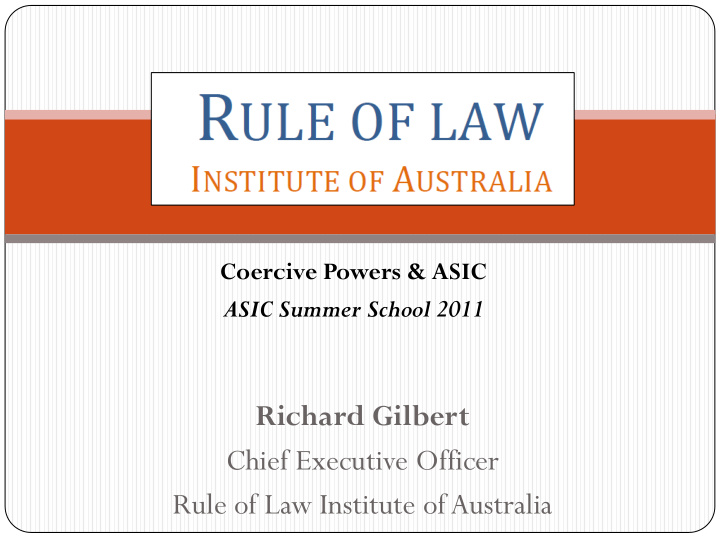



Coercive Powers & ASIC Coercive Powers & ASIC ASIC Summer School 2011 Richard Gilbert Chief Executive Officer Rule of Law Institute of Australia
RoLIA The Rule of Law Institute is an independent non-profit association formed to uphold the rule of law in Australia. The Institute's objectives are: To foster the rule of law in Australia. To promote good governance in Australia by the rule of law. To encourage truth and transparency in Australian Federal and State governments, and government departments and agencies. To reduce the complexity, arbitrariness and uncertainty of Australian laws. To reduce the complexity, arbitrariness and uncertainty of the administrative application of Australian laws 2
Coercive powers of Federal Regulators Require compulsory attendance at examination to answer questions Require production of documents/books Require reasonable assistance (including preparing documents/statements) Require person to allow search of premises without prior notice (ATO only) Departure prohibition orders (ATO only) 3
Significance for rule of law Risk of significant penalty for non-compliance (eg 100 penalty units, 2 years imprisonment or both for not complying with requirement of appearance at examination) Abrogated right against self-incrimination (even with s 68(3) ASIC Act use immunity meaning that evidence cannot be used in subsequent criminal or civil penalty proceedings). However justified, coercive powers diminish fundamental rights and freedoms Coercive powers are powers which would normally be sanctioned by an independent judiciary Coercive powers are extraordinary powers which in most cases even the police do not have access to Only recent confirmation that there is application of legal professional privilege to ASIC coercive powers (Dec 2007) 4
What are politicians have said They certainly give very substantial rights to the task force, arguably rights far greater than police have, so you have the bizarre situation where building union officials and employees in the construction industry actually have fewer rights in relation to investigation by the task force than a criminal might have in relation to investigation by police. Senator Penny Wong ABCC legislation 2005 5
Given their gravity they need: Due process Checks and balances Transparency both in process and outcome Accountability Data is critical – regulatory impact and outcomes – useful indicator of activity 6
ASIC Coercive powers The five most frequently used powers by ASIC over the period 1 July 2007 to 17 June 2010 are: Section 33 of the ASIC Act- notice to produce documents in person's 1. possession (6984 occasions); 2. Section 30 of the ASIC Act- notice to produce books about affairs of body 3. corporate or registered scheme (5687 occasions); Section 19 of the ASIC Act- notice requiring appearance for examination 4. (3354 occasions); Section 31 of the ASIC Act- notice to produce books about financial 5. products(1430 occasions); and Section 912C of the Act- direction to provide a statement (939 occasions). 6. Source: Senate Economics Committee answers to questions on notice, June 2010 session, Question BET 24. 7
Publication of data in annual reports 2009-2010 Reporting item ACCC ACC APRA ATO ASIC ABCC Number of notices x x x Notices by type (for interview or document production) x x x Notices by area of compliance x Challenges to the validity of notices x x x Search warrants sought x Warrants executed/granted x x* Description of matters for which warrants sought x Explanation of the powers and how they work x x State by state breakdown x Proceedings begun for failure to attend examination x x Breakdown by type of examinee Eg management or employees x Outcome of examinations (proceedings commenced, investigation closed etc). x Legal representation at interview x Explanation of why increase/decrease in number of notices x Telecommunications warrants 8 *The ATO disclosed on its use of access-without-notice powers by stating they used the powers on 10 occasions. It is the only regulator with these powers; the other regulators must apply to Court for a warrant which is then executed by the AFP.
Information disclosed about coercive powers Regulator Specific Coercive Some No Disclosed General information/ powers Policy information on information on information at statistics in document on available on website website Senate annual report website website estimates on use of hearings powers ACCC APRA ATO Mention of access- without notice powers only ASIC ABCC 9
Examinations/notices to attend examinations per Federal Regulator 2007/2008 2008/2009 2009/2010 ASIC 1175 1065 1069 (till 17 June 2010) ACCC 163 35 75 ACC 895 summons, 760 627 summons, 527 169 exams exams exams ABCC 54 60 27 * ATO and APRA do not disclose use of their compulsory examination powers. 10
Administrative Review Council 20 Principles on coercive powers May 2008 Record keeping Principle 3 Transparency Principle 4 11
In relation to information - to ascertain industry trends Consider voluntary surveys first and/or sample surveys Seriously test the cost and benefits of complex and onerous data collection Use questionnaires which can be easily completed and collated Try to publish data so that it benefits the market Publish composite data only Avoid secrecy and confidentiality clauses where possible 12
Rule of Law Institute of Australia www.ruleoflaw.org.au (02) 9251 8000 Thank ank you 13
Recommend
More recommend